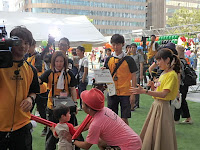August 28, 2018
Annual TV program gives time for Japanese to think about charity for the socially weak
An annual charity program produced by Nippon Television Network Corp., or Nittere, with the key phrase "Love Saves the Earth," has become something like a national event in which many Japanese think about how charity should be for the socially weak. This year's 24-Hour Television, the program called so, was aired around the clock from August 25 to 26 on the Nittere network, drawing an average audience rating of 15.2 percent.
 The instantaneous rating came to as high as 34.7 percent just before the closing event.
The instantaneous rating came to as high as 34.7 percent just before the closing event.Similar charity programs have been launched by some other TV networks. But, despite the strong public attention, the Nittere program draws various views from interested people.
 Some viewers warn of what they see as a tendency of using socially weak people for commercial purposes in excessively moving scenes.
Some viewers warn of what they see as a tendency of using socially weak people for commercial purposes in excessively moving scenes. Organizers say events in the program are aimed at encouraging the socially weak, but they sometimes make viewers feel as if they have to be moved all the time while watching people like handicapped persons, critics say.
Organizers say events in the program are aimed at encouraging the socially weak, but they sometimes make viewers feel as if they have to be moved all the time while watching people like handicapped persons, critics say.The special feature Nittere program, the 41st of its kind, focuses mainly on events for enhancing public awareness about challenges facing disabled and handicapped people as well as those who need welfare.
 Programs aired this year included footage of a girl with an artificial leg trying to scale a 3,000-meter mountain with a special support team and a boy drummer with glass eyes who played a session with a top stage musician.
Programs aired this year included footage of a girl with an artificial leg trying to scale a 3,000-meter mountain with a special support team and a boy drummer with glass eyes who played a session with a top stage musician.The 24-Hour Television for 2018 linked a total of seven event sites nationwide. At a special stage built in front of the north gate to Japan Railways' Hakata Station in Fukuoka, southwestern Japan, many kids were seen playing with colorful twisted balloons.
 With balloon walls put up around to make a balloon art square, students attending a local vocational college were on hand to take care of children and their parents.
With balloon walls put up around to make a balloon art square, students attending a local vocational college were on hand to take care of children and their parents.Next to the balloon square was a booth set up by a major domestic detergent maker, one of the six corporate supporters to the program this year, to promote its recycle-reuse campaign to collect used clothes from consumers and send them to poor countries.
 During the two-day program, donations were accepted at the event sites nationwide for use to programs in three areas, welfare, environmental protection and relief for disaster-affected people.
During the two-day program, donations were accepted at the event sites nationwide for use to programs in three areas, welfare, environmental protection and relief for disaster-affected people. The viewer audience rate climbed toward the end of the program, as a 33-year-old comedian, selected as this year's charity runner, cut the goal tape at the Tokyo site after covering a distance of 161.5 kilometers in a triathlon race.
The viewer audience rate climbed toward the end of the program, as a 33-year-old comedian, selected as this year's charity runner, cut the goal tape at the Tokyo site after covering a distance of 161.5 kilometers in a triathlon race. Japanese people have become even more aware of the importance of binding together to strengthen their mutual ties since the devastating earthquake and killer tsunami waves of March 2011, which claimed some 20,000 lives mainly in the Tohoku region of northeastern Japan.
Japanese people have become even more aware of the importance of binding together to strengthen their mutual ties since the devastating earthquake and killer tsunami waves of March 2011, which claimed some 20,000 lives mainly in the Tohoku region of northeastern Japan.The roles for the media to help boost the spirits of mutual help broadly in Japan's society may become more important than ever in the years ahead.
